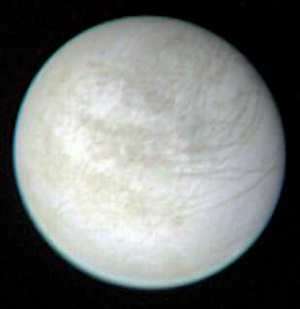Jupiter is the fifth planet from the Sun and the largest planet in the Solar System. The Jovian system is made up of Jupiter and the many moons orbiting it. To date, 67 of these satellites have been discovered.
Planet Jupiter
Table of Contents
Jupiter is one of five planets that can be seen by the naked eye (Mercury, Venus, Mars, and Saturn are the other four); in fact, it is the second brightest planet after Venus. In terms of visibility, Jupiter is a night planet. It is best seen from dusk until the early morning. Its location, however, varies with the time of year, day, and time. The best way to locate the planet is to determine its relative position from the constellations and stars.
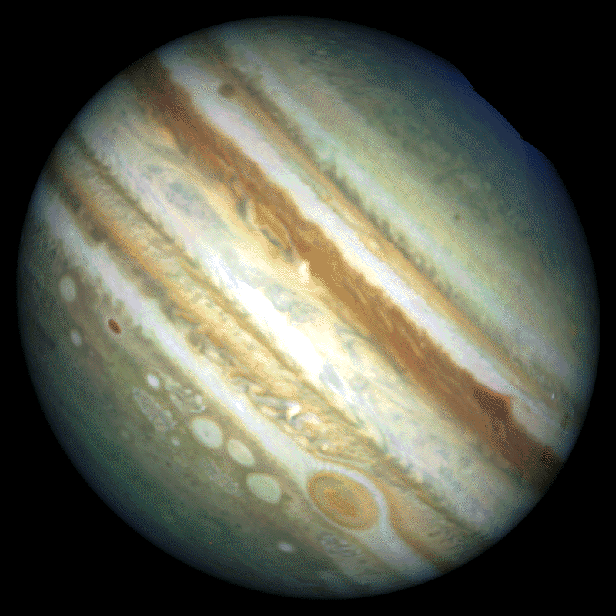
For example, at the beginning of 2013, Jupiter was visible in the southeastern night sky near the star Aldebaran in the constellation of Taurus where it can be seen until the end of May. The Sun’s glare will mask Jupiter from late May until the middle of July, after which it will become visible again as it enters the constellation Gemini just north of Orion. Throughout the rest of 2013 and until mid-2014, Jupiter will travel through Gemini and can be observed southwest of its two brightest stars Castor and Pollux.
Jupiter appears brightest in the night sky when it reaches opposition to the Sun. It is also during this period when it is closest to the Earth. This happens, on average, every 398.9 days. The last time this occurred was on December 3, 2012.
It is unclear when Jupiter was first noticed by humans. The earliest record of the planet was found in ancient Babylonian texts from 800 to 700 BC in which Babylonian astronomers called it Marduk, after the Mesopotamian god and patron deity of the city of Babylon during the Hammurabi period (1800 BC). The planet was later referred to as Zeus by the ancient Greeks and Jupiter by the Romans.
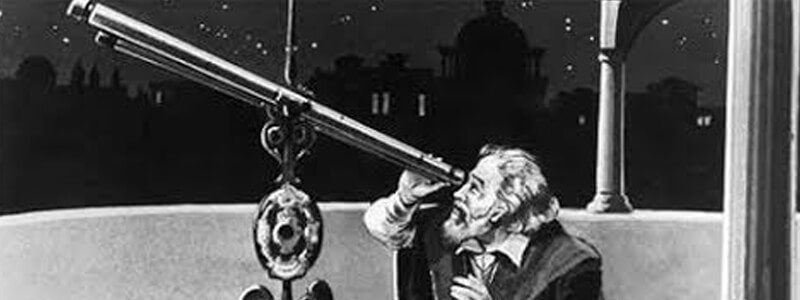
On January 7, 1610, the astronomer Galileo trained his telescope on Jupiter and was the first person to observe the planet’s four largest moons: Io, Europa, Ganymede, and Callisto. These four moons are also called Galilean satellites after their discoverer. In 1664, the English physicist Robert Hooke was the first to notice a big red spot on Jupiter’s surface. This spot later became known as the Great Red Spot and is still visible to this day, which makes it at least 350 years old.
Nothing more was learned about Jupiter until The United States’ National Aeronautics and Space Administration (NASA) launched several spacecraft missions to the planet and beyond starting in the 1970s. Its first mission to Jupiter was launched in March 1972 with the spacecraft Pioneer 10. Pioneer 10 was the first man-made object to cross the asteroid belt and also the first one to take images of Jupiter, which it accomplished on November 6, 1973. In April 1973, NASA launched Pioneer 11, which arrived in Jupiter’s vicinity on September 1979. The spacecraft sent back the first detailed and close-up photographs of Jupiter’s Great Red Spot. In 1977, two spacecraft were launched to study Jupiter and its many moons: Voyager 2 in August followed by Voyager 1 in September.
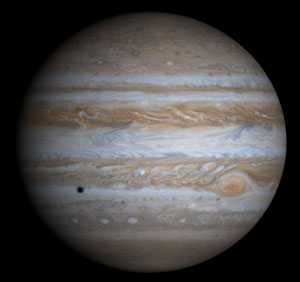
The two missions sent back photographs that revealed that, among other things, the Great Red Spot was a complex storm of gases and that the Jovian moon Io had many active volcanos on its surface. The Voyager 1 spacecraft also discovered faint rings surrounding the planet. In December 1995, the spacecraft Galileo arrived in Jupiter. Unlike its predecessors, which only orbited the planet, Galileo had a probe as well as being an orbiter. The probe was dropped into Jupiter to study its atmosphere while the orbiter continued research into Jupiter’s moons. Galileo was also the only spacecraft that had a direct view of Jupiter when the comet Shoemaker-Levy crashed into the planet in 1994. The spacecraft’s mission was concluded in September 2003. NASA’s latest mission to Jupiter, named Juno, was launched in August 2011. It will study how the planet formed by investigating its atmospheric structure and measuring its gravity field and magnetic field. The spacecraft is expected to arrive at its destination in July 2016.
When Was Jupiter Discovered?
Here are some interesting facts about the planet Jupiter. It is unknown when Jupiter was discovered and who discovered Jupiter. This is because at times Jupiter is visible to the naked eye from Earth, so it would be like saying who and when was Earth’s moon discovered.
Another cool fact about Jupiter is that it is a Gas (Jovian) planet that has the Great Red Spot which is a giant storm which has been going on for hundreds of years and is three times the size of Earth.
Jupiter’s atmosphere composition is 74.9% hydrogen and 23.8% helium. How about this as cool fact about Jupiter: If you weigh 150 pounds on Earth, then you would weigh 380 pounds on Jupiter because Jupiter’s surface gravity is 24.79 m/s2 or 81.3 ft/s2. If being heavy on Jupiter wasn’t enough motivation for you to not want to live there, how about the fact that the average temperature there is -148°C or -234°F.
Mass, Size, and Volume of Jupiter
Jupiter facts about its size are fascinating. Jupiter is the largest planet in our solar system, a matter of fact, it is so large you could fit over 1,300 Earth’s inside it or in other words, you would need 11 Earths to just go from one end of Jupiter to the other. Jupiter’s mass is a whopping 318 times the amount of Earth.
For the geeks who like the numbers, the Density of Jupiter is 1.326 g/cm3, which is about four times more than Earth. Its Diameter (average) is 139,822 km or 86,881 miles. The Equatorial Circumference is 439,263.8 km or 272,945.9 miles. Another cool fact about Jupiter is its Mass is 1.898130 x 1027 kg (yes that is 27 digits after the dot). Its Surface Area is 61,418,738,571 km2 or 23,713,907,537 mi2, which is about 120 times larger than Earth. And the last amazing fact about Jupiter’s size is that its Volume is 61,418,738,571 km2 or 23,713,907,537 mi2, which is about 120 times larger than Earth’s.
What is Jupiter’s Orbital Period?
Now let’s get to some facts about Jupiter’s orbit. Jupiter is the 5th planet from the Sun and is 778,340,821 km or 483,638,564 miles away from the Sun, which is five times more from the Earth is from the Sun. Jupiter travels this orbit at an average velocity of 47,002 km/h or 29,205 mph (half the speed of Earth), at an Orbit Inclination of 1.304°. Another interesting fact about Jupiter is the orbit circumference of Jupiter (the distance it must travel to complete one trip around the Sun) is 4,887,595,931 km or 3,037,011,311 miles.
This long-distance means it takes Jupiter 4,332.82 Earth days (almost 12 Earth years!) to complete this one trip around the Sun. Although Jupiter’s year is much more than Earth’s, its length of the day is only 9.92496 hours (Jupiter’s day is over before we even eat lunch!). Jupiter’s axial tilt is 3.1°. The last facts on Jupiter’s orbit are that its Orbit Eccentricity (how much it deviates from a perfect circle around the Sun) is 0.04838624, which is about three times more than Earth.
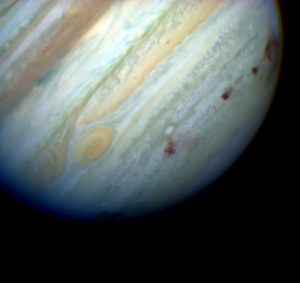 It was Claudius Ptolemy, the Greco-Roman astronomer that lived the 2nd century AD, who first calculated Jupiter’s orbital period. In his astronomical and mathematical treatise Almagest, Ptolemy determined that Jupiter took 11.86 years (or 4,332.38 days) to orbit around the Earth. Ptolemy was a proponent of the geocentric model in astronomy, which held the view that the Earth was the center of the universe and all celestial bodies orbited around it.
It was Claudius Ptolemy, the Greco-Roman astronomer that lived the 2nd century AD, who first calculated Jupiter’s orbital period. In his astronomical and mathematical treatise Almagest, Ptolemy determined that Jupiter took 11.86 years (or 4,332.38 days) to orbit around the Earth. Ptolemy was a proponent of the geocentric model in astronomy, which held the view that the Earth was the center of the universe and all celestial bodies orbited around it.
Aryabhata, an Indian mathematician and astronomer, also calculated Jupiter’s orbital period at 11.86 years (or 4,332.27 days) in 499 AD using the geocentric model. It was not until the 16th century when the geocentric model was challenged by Nicolaus Copernicus, who presented a mathematical model of a heliocentric system in which the Sun was the center of the Solar System and the Earth and other planets orbited it. Regardless of this change in view, Ptolemy’s calculation of Jupiter’s orbital period were later proven accurate, although this time it would be the Sun that Jupiter orbited.
What is the Surface Gravity of Jupiter?
Jupiter’s surface gravity is 24.79 m/s2 or 81.3 ft/s2. It is 2.4 times more than Earth’s, so if you weigh 100 pounds on Earth then you would weigh 240 pounds on Jupiter. Its gravity is so strong that the escape velocity is 216,720 km/h or 134,664 mph (5.38 times more than Earth’s).
Jupiter being the most massive with the highest gravity than any other planet in our solar system helps give it the reputation as being the “vacuum cleaner” of our solar system. This is because space objects like comets and asteroids that are unstable which could even collide with Earth or other planets can get a change in direction or even pulled into Jupiter due to its great mass and gravitational pull. A matter of fact for about 7 days from July 16 through July 22, 1994, at least 21 pieces with diameters of about 2 km of an object known as “Comet Shoemaker-Levy 9” collided with Jupiter from its superior gravitational pull.
Moons and Rings
Right when you thought that’s a lot of facts about Jupiter, but that is the tip of the iceberg until you get to Jupiter’s Moons and rings. There are 67 Moons orbiting Jupiter more than any other planet in our solar system.
Some of the notable Moons are the Galilean moons: Io, Europa, Ganymede, and Callisto. An interesting fact about Jupiter’s moon Ganymede is that it is the largest moon in our solar system, a matter of fact; it is even more significant than the planet Mercury!
But the most intriguing moon is Europa, which suggests to the scientist there may be the existence of life on this moon because of its water ice surface. All of Jupiter’s moons are in one of its 3 Rings: “Main,” “Halo,” and “Gossamer.”

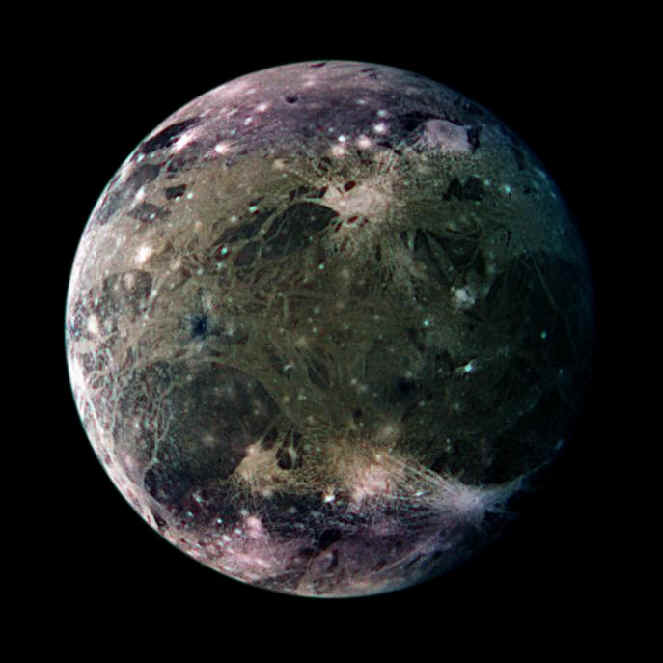
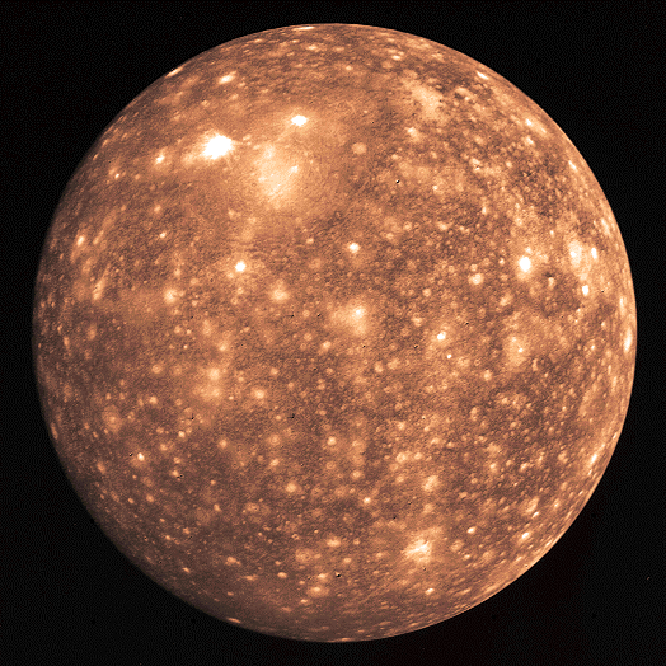
Juno Mission
On August 5th, 2011 NASA launched the Juno mission; the spacecraft is expected to arrive at Jupiter on July 5th, 2016. The purpose of this mission is to determine the origin and evolution of Jupiter, which ultimately will help us understand the beginnings of our solar system. The reason why scientists believe Jupiter holds the secrets to the beginning of our solar system is that like the Sun, Jupiter is mainly composed of hydrogen and helium capturing most of the material from the Sun when it was formed.
Additionally, unlike Earth, Jupiter’s giant mass allowed it to hold onto its original composition, making it easier to trace to the beginnings of our solar system. When Juno arrives at Jupiter, it will orbit 32 times around Jupiter for over a year, and then it will be de-orbited and fall within Jupiter where it will most likely be destroyed.
Images of Jupiter and it’s moons
Jupiter’s Red Spot
The great red spot of Jupiter in its beauty. This image was captured on July 6, 1996, by Voyager 2 during the Voyager mission from 2,633,003 kilometers or 1,636,072 miles.
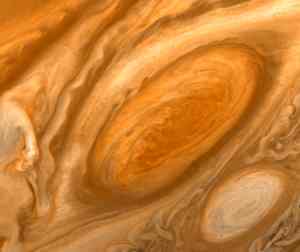
Jupiter’s Moon Io
Io this is one of Jupiter’s moons. This image was captured on January 1, 2001, 10:00 (UTC) by Cassini Orbiter during the Cassini-Huygens mission. Although it looks like Io is close to Jupiter in this image, it is 350,000 kilometers or 217,479 miles from Jupiter, which is equivalent to 2.5 Jupiters.
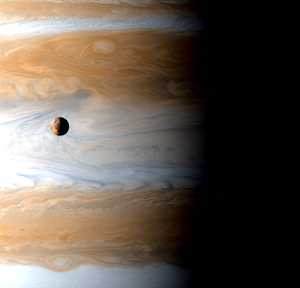
Volcanic eruption on Jupiter’s Moon Io
Volcanic eruptions at Tvashtar Catena a chain of giant volcanic calderas on Jupiter’s moon Io. This image was captured on February 22, 2000, by Galileo Orbiter during the Galileo mission. This color mosaic was created by combining images taken in the near-infrared, clear, and violet filters from Galileo’s camera. The bright orange, yellow, and white areas at the left of the mosaic use images in two more infrared filters to show temperature variations, orange being the coolest and white the hottest material. This picture is about 250 kilometers or 155 miles across.
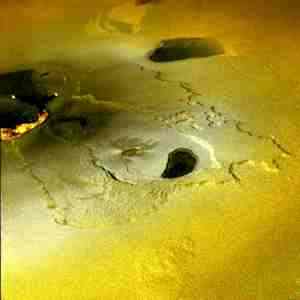
Jupiter’s Moon Europa
Europa, this is one of Jupiter’s moons. This image was captured on March 2, 1999, by Voyager 1 during the Voyager mission from 2,869,252 kilometers or 1,782,870 miles. The dark intersecting lines may be faults on the surface.
Who Discovered Jupiter?
It is unknown who discovered Jupiter. This is because Jupiter at times can be seen by the naked eye (no telescope needed). Jupiter is the 2nd brightest planet in the night sky (Venus is 1st).
The earliest record of the planet was found in ancient Babylonian texts from 800 to 700 BC in which Babylonian astronomers called it Marduk, after the Mesopotamian god and patron deity of the city of Babylon during the Hammurabi period (1800 BC). The planet was later referred to as Zeus by the ancient Greeks and Jupiter by the Romans.
On January 7, 1610, the astronomer Galileo Galilee trained his telescope on Jupiter and was the first person to observe the planet’s four largest moons: Io, Europa, Ganymede, and Callisto. These four moons are also called Galilean satellites after their discoverer. In 1664, the English physicist Robert Hooke was the first to notice a big red spot on Jupiter’s surface. This spot later became known as the Great Red Spot and is still visible to this day, which makes it at least 350 years old.
The image on the right was taken by Marek Nikodem on March 18, 2012, outside Szubin, Poland. In the photo, Jupiter is at the left hand, and Venus is at the right hand of the person.
References:
• Jupiter by Planets of the Solar System
• Jupiter Facts by Solar System Facts
• Solar System Exploration: Jupiter by NASA
• The Planetary System (book) by David Morrison and Tobias Owen

